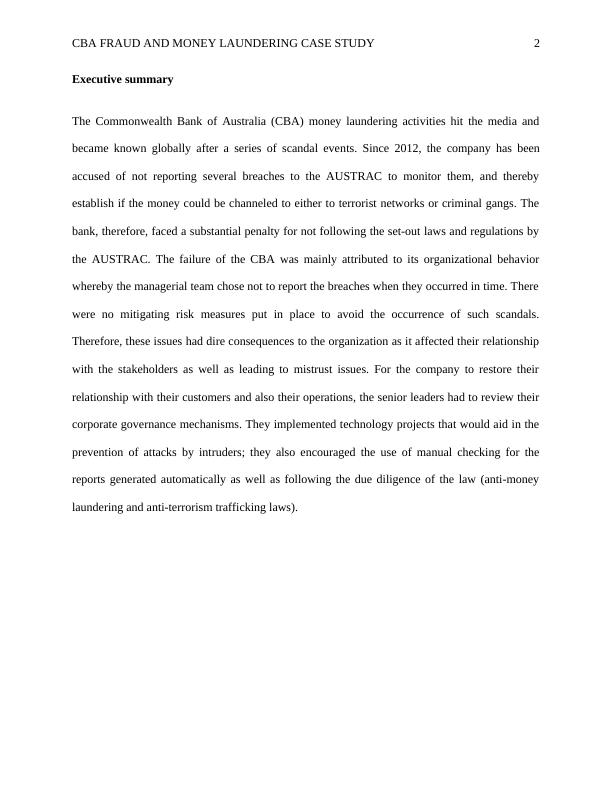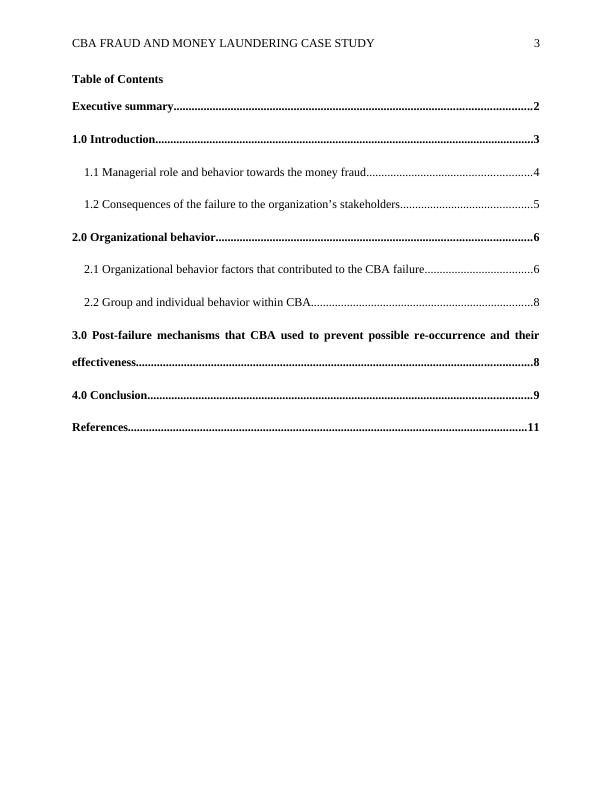CBA Fraud and Money Laundering Case Study
Added on 2023-06-03
13 Pages3303 Words300 Views
CBA FRAUD AND MONEY LAUNDERING CASE STUDY 1
THE COMMONWEALTH BANK OF AUSTRALIA (CBA) FRAUD AND MONEY
LAUNDERING CASE STUDY
Name
Institution
Tutor
Date of Submission
Word count (Excluding references and executive summary)
(2005 words)
THE COMMONWEALTH BANK OF AUSTRALIA (CBA) FRAUD AND MONEY
LAUNDERING CASE STUDY
Name
Institution
Tutor
Date of Submission
Word count (Excluding references and executive summary)
(2005 words)

CBA FRAUD AND MONEY LAUNDERING CASE STUDY 2
Executive summary
The Commonwealth Bank of Australia (CBA) money laundering activities hit the media and
became known globally after a series of scandal events. Since 2012, the company has been
accused of not reporting several breaches to the AUSTRAC to monitor them, and thereby
establish if the money could be channeled to either to terrorist networks or criminal gangs. The
bank, therefore, faced a substantial penalty for not following the set-out laws and regulations by
the AUSTRAC. The failure of the CBA was mainly attributed to its organizational behavior
whereby the managerial team chose not to report the breaches when they occurred in time. There
were no mitigating risk measures put in place to avoid the occurrence of such scandals.
Therefore, these issues had dire consequences to the organization as it affected their relationship
with the stakeholders as well as leading to mistrust issues. For the company to restore their
relationship with their customers and also their operations, the senior leaders had to review their
corporate governance mechanisms. They implemented technology projects that would aid in the
prevention of attacks by intruders; they also encouraged the use of manual checking for the
reports generated automatically as well as following the due diligence of the law (anti-money
laundering and anti-terrorism trafficking laws).
Executive summary
The Commonwealth Bank of Australia (CBA) money laundering activities hit the media and
became known globally after a series of scandal events. Since 2012, the company has been
accused of not reporting several breaches to the AUSTRAC to monitor them, and thereby
establish if the money could be channeled to either to terrorist networks or criminal gangs. The
bank, therefore, faced a substantial penalty for not following the set-out laws and regulations by
the AUSTRAC. The failure of the CBA was mainly attributed to its organizational behavior
whereby the managerial team chose not to report the breaches when they occurred in time. There
were no mitigating risk measures put in place to avoid the occurrence of such scandals.
Therefore, these issues had dire consequences to the organization as it affected their relationship
with the stakeholders as well as leading to mistrust issues. For the company to restore their
relationship with their customers and also their operations, the senior leaders had to review their
corporate governance mechanisms. They implemented technology projects that would aid in the
prevention of attacks by intruders; they also encouraged the use of manual checking for the
reports generated automatically as well as following the due diligence of the law (anti-money
laundering and anti-terrorism trafficking laws).

CBA FRAUD AND MONEY LAUNDERING CASE STUDY 3
Table of Contents
Executive summary.......................................................................................................................2
1.0 Introduction..............................................................................................................................3
1.1 Managerial role and behavior towards the money fraud.......................................................4
1.2 Consequences of the failure to the organization’s stakeholders............................................5
2.0 Organizational behavior.........................................................................................................6
2.1 Organizational behavior factors that contributed to the CBA failure....................................6
2.2 Group and individual behavior within CBA..........................................................................8
3.0 Post-failure mechanisms that CBA used to prevent possible re-occurrence and their
effectiveness....................................................................................................................................8
4.0 Conclusion................................................................................................................................9
References.....................................................................................................................................11
Table of Contents
Executive summary.......................................................................................................................2
1.0 Introduction..............................................................................................................................3
1.1 Managerial role and behavior towards the money fraud.......................................................4
1.2 Consequences of the failure to the organization’s stakeholders............................................5
2.0 Organizational behavior.........................................................................................................6
2.1 Organizational behavior factors that contributed to the CBA failure....................................6
2.2 Group and individual behavior within CBA..........................................................................8
3.0 Post-failure mechanisms that CBA used to prevent possible re-occurrence and their
effectiveness....................................................................................................................................8
4.0 Conclusion................................................................................................................................9
References.....................................................................................................................................11

CBA FRAUD AND MONEY LAUNDERING CASE STUDY 4
1.0 Introduction
Money laundering in banks is a severe crime in Australia that has severe consequences for the
bank (Crofts 2018, p. 5). The CBA was established in the year 1991 as a public organization but
became a private company in July 1996. In the year 2015, CBA was hit by the biggest scandal
ever of money laundering. The two men arrested in connection with laundering $1,784,408, on
Thursday night of May 21st, 2015, were Salman Khan- 24 years old and Arlsan Shaffi- 25 years
old. Over $3 million were found in their apartments in banking receipts indicating the CBA’s
deposit machines printed by them. The CBA culture relies mostly on the use of technology and
advanced tools to carry out their operations (Demetis 2018, p. 99). These two men, therefore,
were as well involved in the ‘cuckoo smurfing syndicate,’ which is a method of money
laundering using multiple individuals in making deposits in separate branches of the bank in
various regions. Also, it employs the technique of piggybacking whereby the unwitting
customers make transfers regarding the international legal funds. The top management claim that
the root cause of the problems of CBA was due to software errors. They did not employ
appropriate risk management measures in place, thereby causing the breach of their systems.
This paper, therefore, discusses the CBA money laundering scandals concerning the role that the
mangers played and how the organization failure affected their relationship with stakeholders,
Organizational behavior factors that contributed to the CBA failure, and Post-failure mechanism
that CBA used to prevent possible re-occurrence and their effectiveness.
1.1 Managerial role and behavior towards the money fraud
The AUSTRAC accused the CBA by of failing to report any suspicious matters to the police
(Russell 2018, p. 495). The top management and leadership of the organization have the sole
1.0 Introduction
Money laundering in banks is a severe crime in Australia that has severe consequences for the
bank (Crofts 2018, p. 5). The CBA was established in the year 1991 as a public organization but
became a private company in July 1996. In the year 2015, CBA was hit by the biggest scandal
ever of money laundering. The two men arrested in connection with laundering $1,784,408, on
Thursday night of May 21st, 2015, were Salman Khan- 24 years old and Arlsan Shaffi- 25 years
old. Over $3 million were found in their apartments in banking receipts indicating the CBA’s
deposit machines printed by them. The CBA culture relies mostly on the use of technology and
advanced tools to carry out their operations (Demetis 2018, p. 99). These two men, therefore,
were as well involved in the ‘cuckoo smurfing syndicate,’ which is a method of money
laundering using multiple individuals in making deposits in separate branches of the bank in
various regions. Also, it employs the technique of piggybacking whereby the unwitting
customers make transfers regarding the international legal funds. The top management claim that
the root cause of the problems of CBA was due to software errors. They did not employ
appropriate risk management measures in place, thereby causing the breach of their systems.
This paper, therefore, discusses the CBA money laundering scandals concerning the role that the
mangers played and how the organization failure affected their relationship with stakeholders,
Organizational behavior factors that contributed to the CBA failure, and Post-failure mechanism
that CBA used to prevent possible re-occurrence and their effectiveness.
1.1 Managerial role and behavior towards the money fraud
The AUSTRAC accused the CBA by of failing to report any suspicious matters to the police
(Russell 2018, p. 495). The top management and leadership of the organization have the sole

End of preview
Want to access all the pages? Upload your documents or become a member.
Related Documents
Behavioral Factors Leading to Gross Negligence in Commonwealth Bank of Australialg...
|13
|2346
|243
Commonwealth Bank of Australia (CBA) Money Laundering Scandallg...
|10
|2949
|468
Commonwealth Bank of Australia's Anti-Money Laundering Breachlg...
|7
|1869
|168
CBA Money Laundering Scandallg...
|10
|2310
|15
SQL Structured Query Language Database - doclg...
|9
|1636
|31
Money Laundering Scam of Common Wealth Bank of Australialg...
|11
|2855
|15